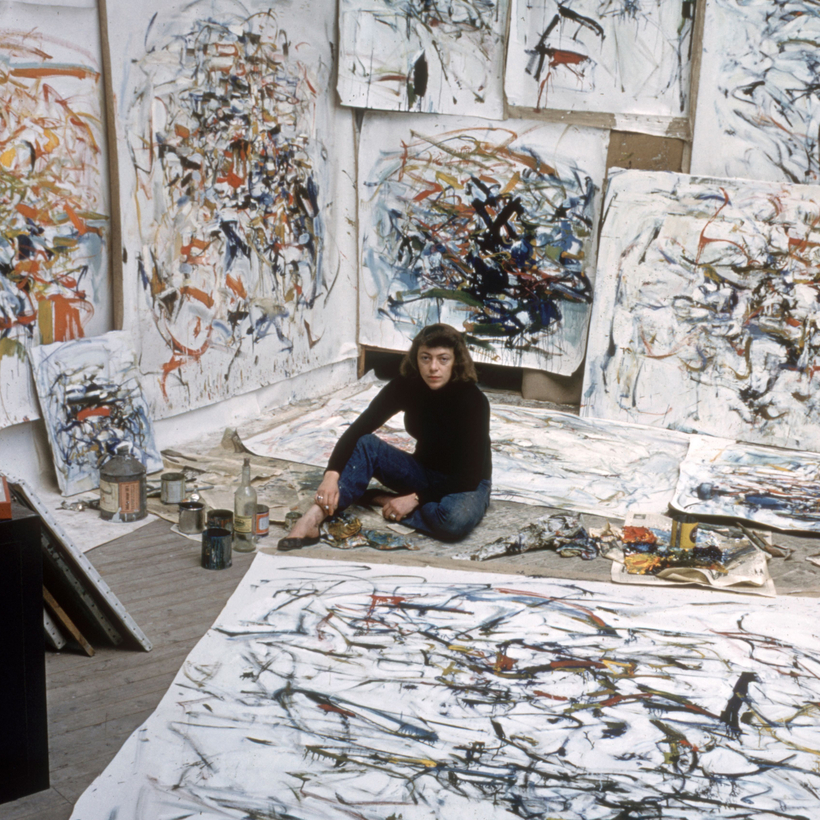The Abstract Expressionist painter Joan Mitchell felt a kinship with weeds. Fierce and oddly beautiful, they stimulated her energetic, tangled images. She often resembled one herself, dressed in slouchy sweaters and worn jeans, the circles under her eyes hidden behind large tinted glasses, the inevitable cigarette dangling from her raw and paint-stained fingers. In the catalogue that accompanies “Joan Mitchell”—a major reconsideration of the artist’s work, opening next week at the San Francisco Museum of Modern Art—Cecilia Wichmann writes, “The struggle with weeding, as with painting, is to determine what is vibrant … and what must be brought under control.”
These words are equally applicable to Mitchell, whose behavior veered between extremes of vitality and chaos. The co-curators of this landmark exhibition, Sarah Roberts and Katy Siegel, bring nuance and complexity to Mitchell’s often reductive reputation as a talented troublemaker. By offering new perspectives on both her work and her refusal to accept conventional gender roles, they assert she was a pioneer who achieved her goal: that of making great art.

Mitchell was born in 1925 in Chicago, to a family that was both Social Register and intellectually engaged. Her mother, who introduced her to literature, was an editor at Poetry magazine. Her father, who introduced her to art, was a renowned doctor. Yet he was also narrow-minded and controlling and had athletic ambitions for her.
Mitchell was simultaneously a medaled ice-skating princess and a deeply insecure but precociously synesthetic young woman who ached to make her mark as a poet or painter—and had the talent to back it up. She came to resent her father’s dictates, which undermined her, and dropped out of his favored school, Smith College, to attend the School of the Art Institute of Chicago, where she was steeped in French painting and found community.
After inspiring summers at the institute’s Lake Michigan campus and in Mexico, and being awarded a travel fellowship, Mitchell followed her high-school beau Barney Rosset to New York, while she waited a year for France to recover more fully from the war. He then followed her to France, where eventually they were married. But frustrated in attempts to translate her intense feelings to the canvas, Mitchell returned to New York in 1949, determined to find a more fluid visual vocabulary. Like lovers, Paris and New York were to battle for her quicksilver affections, as she craved either stimulation or solace.
By 1950, by letting the figure recede and allowing emotion to come to the fore, Mitchell had begun to find her way in the macho world of the New York School. She revered Franz Kline and Willem de Kooning, and they in turn championed her lyrical gestures, even as she drank and brawled with others in their circle during late nights at the Cedar Tavern. She later referred to this side of her personality as “Big Joan.”
Despite the comprehensive 9th Street Art Exhibition of 1951, which included the work of 11 women, Mitchell among them, few female artists were accepted into subsequent gallery shows, making solidarity difficult. But strong friendships with poets such as Frank O’Hara, along with the writings of Baudelaire, provided ballast for Mitchell’s fragile side—“Little Joan.” She discovered that her youthful decision to opt for painting over poetry did not mean she had to abandon the passions that words aroused.

Mitchell had to walk on the wild side to feel alive and creative. In France they called her sauvage; in America, a “cyclone.” By 1952, the intense feelings she’d had for Rosset—who, with her help, took over Grove Press—were lavished on the painter Michael Goldberg; it was to prove a stormy match marked by her suicide attempt. Though a subsequent relationship with painter Jean-Paul Riopelle lasted 24 years, they too were often faithless or feuding. Other short-term affairs, including one with Samuel Beckett, provided respite or added spice.
Mitchell insisted she wanted to paint from love and not violence, but her work was fueled as much by the turmoil as by the peaceful, natural settings that soothed her. Her “seductive pawmarks,” as one critic put it, could come in a flurry of brilliant yellows, cool Prussian blues, verdant greens, or fiery reds, with white as an anchor. Yet every gesture was deliberate.
Van Gogh was her ideal, a painter who imbued brushwork with sensation. “I’m trying to stop time, or frame it,” she claimed. One thinks of the undulating movement in The Bridge (1956) or the evocation of rage in Mud Time (1960), which channels a poem by Robert Frost. In the many multi-part series that had become a Mitchell signature—La Grande Vallée (1983–84) is one example—the paintings percolate with each other and with Mitchell in a kind of group therapy.
Despite solo gallery shows, museum exhibitions, and recognition during her lifetime, Mitchell never quite lost the neediness that defined her. (She might today be consoled by the top prices her work routinely fetches at auction.)
Yet her inability to fully commit to one person or place seemed to vanish upon her purchase of a gracious property with a view of the Seine in Vétheuil, France, where Monet once lived. Nourished by the beauty and the legend, she relinquished the drama—as well as Riopelle—and embraced her outsider status. Mitchell remained in Vétheuil until her death, from lung cancer in 1992, communing with the painters, poets, and composers she revered, surrounded by young acolytes and her beloved sunflowers. The margins were where she’d always felt at ease. There, no one could fully claim her.
“Joan Mitchell” opens September 4 at the San Francisco Museum of Modern Art
Patricia Zohn is a culture columnist who has contributed to numerous publications, including the Huffington Post, The New York Times, and Town & Country

